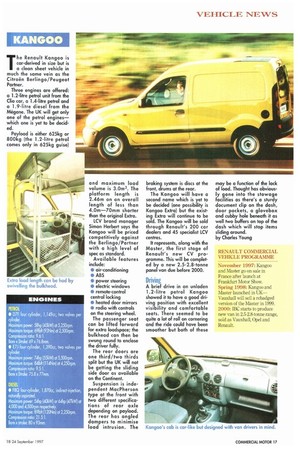A taste of vans nouveaux
Page 18

Page 19

If you've noticed an error in this article please click here to report it so we can fix it.
Renault's Master replacement is an all-new vehicle with no components carried over from the previous model. It will also replace long wheelbase Trafics.
The latest range comprises 88 variants including panel vans, chassiscabs, chassis double-cabs, combis, platform cabs, and chassis cowls. The vans have the option of three wheelbases and three body heights.
Power to the rear wheels comes from two lveco diesel units, a 2.5-litre diesel and a 2.8-litre directinjection turbodiesel. There's also a new Espacederived five-speed unit.
The UK will receive 27 variants, 18 of which will be panel vans. A minibus can be had by buying a glazed van and taking it to a converter.
Load volumes range from 8.0m3 to 13.9m3 (an extra 1.1m3 over the old Master); payloads range from 1,040kg to 1,735kg.
The front suspension is double-wishbone type in which the upper arm is a rocking lever. Rear suspension consists of a tubular "dead" axle with leaf springs. Braking is via 280mm front discs and 280mm diameter drums at the rear with one circuit for the front wheels and one for all four.
Service intervals are 6,000 miles for the 2.5D and 12,000 miles for the 2.8 dTi. Full services are every 36,000 miles.
According to Simon Herbert, LCV brand manager, the Master will be marketed very much against the Transit with a similar level of specification as standard.
The features list is similar to a car's with steering-wheelcontrol radio being among the more unusual.
Vauxhall's version of the Master will be marketed in the early part of 1999 and will have a different specification.
CM drove an unladen short wheelbase 2.5D Master and initial impressions are that it should make Renault very competitive in this sector. It seems well put together with no rattles and it's certainly pleasant to drive. The drivetrain felt refined and was more than happy in fourth gear around town. Gone is the much-criticised umbrella handbrake in favour of a conventional one. The gear change is unbelievably light. The power steering works well and as far as CM could tell there are no problems with ride and handling. The Renault Kangoo is car-derived in size but is a clean sheet vehicle in much the same vein as the Citroen Berlingo/Peugeot Partner.
Three engines are offered: a 1.2-litre petrol unit from the Clio car, a 1.4-litre petrol and a 1.9-litre diesel from the Megane. The UK will get only one of the petrol engines— which one is yet to be decided.
Payload is either 625kg or 800kg (the 1.2-liire petrol comes only in 625kg guise)
and maximum load volume is 3.0m3. The platform length is 2.46m on an overall length of less than 4.0m-70mm shorter than the original Extra.
LCV brand manager Simon Herbert says the Kangoo will be priced competitively against the Berlingo/Partner with a high level of spec as standard.
Available features include: • air-conditioning • ABS • power steering • electric windows • remote-control central locking • heated door mirrors • radio with controls on the steering wheel. The passenger seat can be lifted forward for extra loadspace; the bulkhead can then be swung round to enclose the driver fully.
The rear doors are one third/two thirds split but the UK will not be getting the sliding side door as available on the Continent.
Suspension is independent MacPherson type at the front with two different specifications of rear axle depending on payload. The rear has angled dampers to minimise load intrusion. The braking system is discs at the front, drums at the rear.
The Kangoo will have a second name which is yet to be decided (one possibility is Kangoo Extra) but the existing Extra will continue to be sold. The Kangoo will be sold through Renault's 200 car dealers and 45 specialist LCV centres.
It represents, along with the Master, the first stage of Renault's new CV programme. This will be completed by a new 2.5-2.8-tonne panel van due before 2000.
A brief drive in an unladen 1.2-litre petrol Kangoo showed it to have a good driving position with excellent visibility and comfortable seats. There seemed to be quite a lot of roll on cornering and the ride could have been smoother but both of these
may be a function of the lack of load. Thought has obviously gone into the stowage facilities as there's a sturdy document clip on the dash, door pockets, a glovebox and cubby hole beneath it as well two buffers on top of the dash which will stop items sliding around.
by Charles Young
















































































































